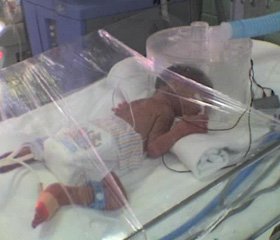Журнал «Здоровье ребенка» 4 (47) 2013
Вернуться к номеру
Bronchopulmonary dysplasia in premature newborns: pathogenesis, clinical features, treatment and prevention.
Авторы: 1V.I. Snysar, 2O.I. Obolonsky. 2D.N. Surkov, 2O.G. Kapustina, 2D.G.Volkov.
1 Dnepropetrovsk Medical Academy of Ukrainian Ministry of Common Health, 49044, Dzerjinskogo St, 9, Dnepropetrovsk, Ukraine
2Dnepropetrovsk Regional Children’s Hospital, 49100, Kosmitcheskaya St, 13, Dnepropetrovsk, Ukraine
Рубрики: Педиатрия/Неонатология
Разделы: Справочник специалиста
Версия для печати
The article and the modern views on the pathogenesis, clinical picture, diagnosis and treatment of bronchopulmonary dysplasia.
Respiratory distress syndrome (RDS) and its consequences, including bronchopulmonary dysplasia (BPD) is the most common variants of respiratory lesions in preterm infants. The use of antenatal steroids in threatened preterm labor and exogenous surfactant in severe respiratory distress syndrome (WBS) significantly improved survival and outcomes in the group of children with extremely low birth weight (ENMT) at birth. Increased survival in a population at high risk for BPD in the last twenty years, accompanied by a stable incidence BPD. Understanding of the pathogenesis of bronchopulmonary dysplasia (BPD) has expanded considerably in recent years. Nevertheless, most used for its treatment methods are not based on evidence.
It took no more than twenty years, as the disease earlier relatively rare, has become a serious problem for neonatologists and pediatricians. Improvement of methods of nursing premature infants poses specialists serious questions on the task of timely diagnosis and treatment changes
respiratory system. The article, prepared on the basis of experience domestic experts and foreign colleagues, highlights pathogenesis, diagnosis, treatment and prevention of bronchopulmonary
pulmonary dysplasia. Bronchopulmonary dysplasia is the most common chronic lung disease in infants. With the improvement of nursing of very preterm infants bronchopulmonary dysplasia occurs more often. In the near future Ukraine can expect an increase in the incidence of BPD, celebrated in other developed countries. This is due to the transition of the Ukraine Health at the WHO recommended criteria for live births and still-governing birth registration with a body weight of 500 g and above, as well as increased survival and improving the nursing of children born with extremely low and very low birth weight. Care for children with BPD is costly. Disability of patients, the presence of they have comorbid conditions, the transition in the next decade BPD patients with a history of adult network, lack of aware- ability of this disease a wide range of pediatricians, the error rate in the diagnosis and management of patients tactics - all this makes the problem BPD is not only a great medical but also social significance.
This review of the literature with the accumulated domestic and international experience offers suggestions for criteria diagnosis and classification of diseases, diagnosis formulation,
measures to care for children at different stages of preventive and therapeutic interventions.
Special attention is paid to the influence of patent ductus arteriosus on the occurrence and severity of bronchopulmonary dysplasia. The mechanisms of the hemodynamic effects of the open flow on blood flow in the anterior cerebral artery, the vessels of the pulmonary circulation, the impact on the development of an open flow of pulmonary edema. Separately the methods for closure of the ductus arteriosus. The advantages of pharmacologic ductal closure. Presents the current strategy for the use of indomethacin, ibuprofen, parenteral and rectal forms.
The article detailed the advantages and disadvantages of surgical clipping of patent ductus arteriosus.
Early closure of patent ductus arteriosus (PDA) by ibuprofen or indomethacin and, with no effect of drug therapy, surgical ligation ducts probably have a positive impact, although evidence of the effectiveness of this method for the prevention of BPD is not enough.
The frequency of occurrence of hemodynamically significant PDA is inversely proportional gestation age and birth weight, so the newborn gestational age (GA) less than 28 weeks and weighing less than 1000 grams need to treat VAP is 55-70%.
Most newborns with hemodynamically significant PDA require prolonged mechanical ventilation and oxygen subsidies, the frequency of PDA increases with decreasing GA. Thus, the risk factors for the formation of BPD, and therapeutic aspects of PDA match. In addition, several studies have shown that the functioning independently and PDA, especially when combined with an infectious process, a risk factor for the formation of BPD.
There are 3 methods of preterm infants with hemodynamically significant PDA: conservative management (limiting the amount of fluid and surveillance), surgery, medication close by PDA. Recently, conservative management of newborns with PDA actively discussing medical community. Evidence that any benefits of surgical treatment method PDA before medication to date there. Comparison of different strategies of drug therapy hemodynamically significant PDA devoted a large number of studies. However, to date, three major questions "the cure?", "When to start treatment?", "When start clipping?" Remain unresolved.
Prevention and treatment of BPD - the most difficult task of modern neonatology. BPD - is a multifactor disease, so reduction its frequency and severity necessary multimodal approaches . The use of antenatal steroids, prophylactic or early surfactant administration, closing hemodynamically significant PDA, careful use of oxygen restrictive fluid therapy (limited by volume), early use of caffeine for the prevention and treatment of sleep apnea, inhaled corticosteroids and bronhodilyatatar - possible methods for reducing the risk of BPD in very low birth weight infants. The use of systemic corticosteroids is not desirable due to their serious side effects. It remains an open question about the impact of timing closure hemodynamically significant PDA on the severity of BPD recommended terms and schemes pharmacological closure of hemodynamically significant PDA, duration, clear and urgent clinical indications for clipping PDA. In terms of respiratory support, preferred approaches to minimize invasive ventilation or, in case of need, reducing volyumotravma, the introduction of a broad practice synchronized noninvasive ventilation (SNIPPV) instead of traditional CPAP therapy.
The article displays modern strategies of invasive and noninvasive respiratory therapy. Knowing the causes and mechanisms of the pathogenesis of bronchopulmonary dysplasia in practice will help better diagnose and help babies in all phases of hospital and outpatient care.

